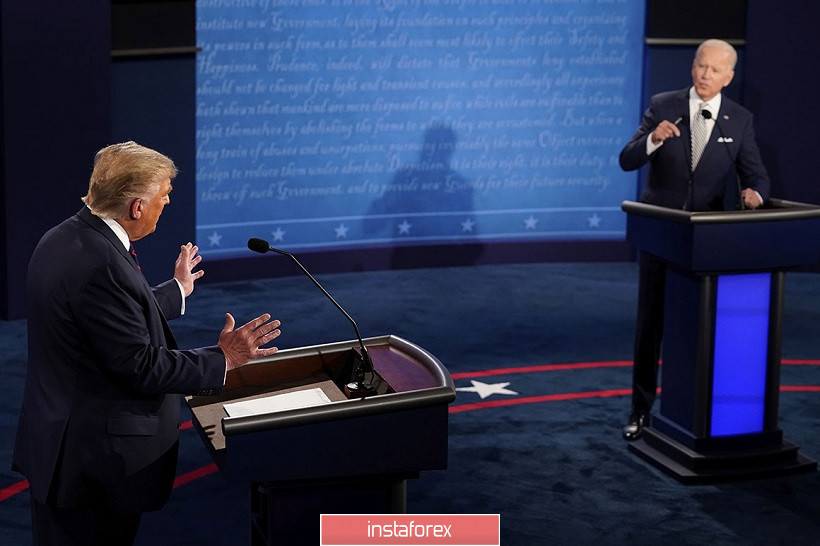The debate of the US presidential candidates was ignored by the currency market, which took place during the Asian session on Wednesday. The dollar index retreated slightly, returning to the 93rd figure, but in general, the political show went "past" traders. However, we are talking about the initial reaction of the market, since there was no clear "winner" during the debate. The US President often ridiculed Biden, who, in turn, tried to follow his own line of behavior and did not react to this style of communication. However, he also sometimes adheres to conflict, calling Trump a "liar" and "clown". Contrary to tradition, they did not shake hands – either before or after the debate.
Assessing the results of this debate, political experts stated that they set a record of so-called "non-parliamentary expressions", although they did not determine the clear winner. Therefore, the market formally reacted to this. First, this was only the first round of debate, and second, without a clear favorite, traders prefer not to jump to conclusions. As a rule, research agencies conduct opinion polls after the end of the debate and its results will determine the winner.

Meanwhile, the EUR/USD pair slowed down, which was driven solely by the weakening of the US currency. Buyers were unable to leave the Kumo cloud on the daily chart (the upper limit of which corresponds to 1.1805), due to which the upward impulse gradually faded. In addition, the macroeconomic statistics published yesterday did not contribute to the pair's further growth.
First, German inflation failed. After a sharp surge in June, the CPI has been in the negative zone since July, both on an annual and monthly terms. According to preliminary forecasts, this indicator should have increased to zero level in monthly terms, and to 0.1% in annual terms. However, it came out in the "red zone": -0.2% (m/m), -0.2% (y/y). The harmonized consumer price index also showed a similar trend: -0.4% (m/m), -0.4% (y/y). Germany is considered the driver of the European economy, so such figures are a very alarming signal.
The data published yesterday serves as a signal of weak pan-European figures, in the context of Friday's release on the inflation growth in the Eurozone. The forecasts are quite pessimistic: according to analysts, the overall index will remain in the negative zone and will be marked at -0.1%. Core inflation should also show a negative trend. Analysts believe that the core index will be released at 0.3%. If the September inflation figures in Europe come out at least one-tenth of a percent below forecasts, the Euro will be under strong pressure. Given the decline in German inflation, there are certain prerequisites for the implementation of this scenario.
On another note, US statistics surprised investors yesterday. September's consumer confidence surged to its highest level since the start of the pandemic. The indicator came out at around 101 points, significantly exceeding the forecasted values. At the same time, the rate of increase in the index became the maximum over the past 17 years (the indicator rose by 15 points at once, which has not happened since the spring of 2003).
However, all these releases did not provoke strong volatility in the pair. They only stopped the growth of EUR/USD, which is due to USD weakness. Let me remind you that this week, the dollar bulls demonstrate their indecision amid political divisions in the US Congress. The representatives of the Democratic Party refused to negotiate with Republicans for the development of a bipartisan bill to provide assistance to the US economy, proposing their own version of the law in the amount of $ 2.2 trillion. It is clear that this bill will not gain the force of law, since it will not be approved by the Senate and will not be signed by Donald Trump. In other words, things don't change, despite the optimistic statements of US Treasury Secretary Steven Mnuchin. Unfortunately (for dollar bulls), his optimism was unjustified again; therefore, congressmen are unlikely to be able to adopt a consolidated document before the presidential election.

All this suggests that the EUR/USD pair in the medium term will be trading in a flat, in a fairly wide price range of 1.1805-1.1630, where the "ceiling" corresponds to the upper border of the Kumo cloud on D1 and the lower level to the lower line Bollinger Bands indicator on the same time frame. This "gap" is likely to persist until Friday, when September Nonfarms will be published. Thus, if we approach the upper border of the range, it is advisable to consider short positions, but if we approach the lower line of the range, we should consider long positions.
Moreover, since both the dollar and the euro are currently weakened (the single currency is also under additional pressure from the ECB), traders are likely to fail breaking through the border of the above range in the coming days.
 English
English 
 Русский
Русский Bahasa Indonesia
Bahasa Indonesia Bahasa Malay
Bahasa Malay ไทย
ไทย Español
Español Deutsch
Deutsch Български
Български Français
Français Tiếng Việt
Tiếng Việt 中文
中文 বাংলা
বাংলা हिन्दी
हिन्दी Čeština
Čeština Українська
Українська Română
Română

